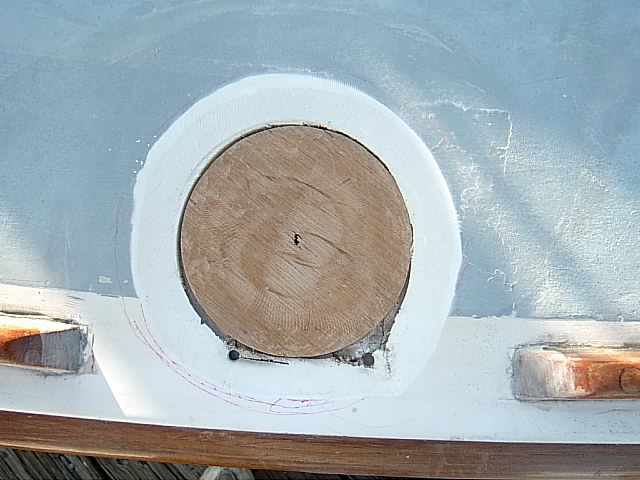Something Else had some Stanchion issues when I bought “her”. I’m not sure Something Else is female but traditionally boats are called “her” so I will fall in step. A stanchion is a post sticking up from the perimeter of the deck to support the life lines. My boat and many boats made in Europe during the 60’s and 70’s used solid aluminum stanchions. They are 24 inches tall with a triangular base held on with three screws. The life lines are stainless 3/16 steel cables and are intended to prevent the crew from falling overboard. Two of the stanchions bases on the port side had broken thru the deck. This must have been caused by an impact with a dock or another boat. The stern pulpit was also bent over on the port side. Oh the sins on the PO. With the outer layers of the deck broken, water was able to seep into the balsa core of the deck. The balsa rotted locally and no longer provided structural rigidity.
The first step was to remove the stanchion. The nuts were encapsulated in fiberglass. This had to be ground and chiseled away. The nuts and screws were removed and the stanchion was easily removed. Exploratory surgery was required to determine the extent of the damage to the core. Deck material was removed until all the damaged deck and core were removed and solid good material was exposed. The area was bowled out to provide a tapper of about 10:1. This allows the layers fiberglass area to bond to. Next a new core was fabricated from marine plywood. The core was bonded with thickened epoxy to the existing core and the bottom fiberglass layers. 12 oz. fiberglass cloth was laid up with epoxy resin. This was topped with peel ply (a Dacron fabric), waxed paper, a piece of plywood and finally a 25 lb weight. After the epoxy cured the weight, plywood and waxed paper were removed. The peel ply was pulled off which left a nearly perfect surface. The area was sanded and faired then painted to protect the epoxy from UV exposure. The original aluminum stanchions are being replaced by polished stainless steel stanchions that are the norm on sail boats here in the US. I got these at the yacht salvage store. They sure are pretty. I had the stern pulpit straitened at a local shop that makes pulpits for many manufactures since the 60’s. I am holding off the final installation of the stanchions and pulpits until I paint the whole deck.
 |
| Damaged deck from stanchion |
 |
| Inside veiw of damaged deck. View looking up. |
 |
| Rotted balsa core. |
|
|
| Replacement core and 10:1 tapper for fiberglass repair |
 |
| Repair prior to sanding and paint. |
 |
| Sanded and primed. |
 |
I have 8 solid aluminum stanchions for sale! |








Wow, Greg! Another impressive repair job, and proof again of your sail-boat related handy-man skills.
ReplyDeleteI think I understand enough of your blog entry to get a good idea of the many steps this fix-it job required. No easy task. It must take a lot of time to make this type of repair. From the photos, it appears you did the work well and very successfully. Stainless steel stanchions should look much nicer that the aluminum ones.
By the way, I suspect your boat's "pulpits" are very different from the kind of pulpit I'm familiar with. But, in your blog comments, after you first mention the port-side pulpit damage, you then refer to the PO's "sins"...well, talking about a "pulpit" and "sins" closely together is something I'm familiar with!
Anyway, this is another very interesting and informative blog entry.
Stern Pulpit does sound like a stern (i.e. expressing strong disapproval or criticism) style of preaching.
Delete“Wow the priest gave us a stern pulpit at mass today!”
Something Else’s stern pulpit is made of stainless steel tubing and forms a safety rail around the back of the boat. The bow pulpit is a safety rail around the front of the boat. The lifelines connect from the stern pulpit to the bow pulpit. This provides a continuous safety perimeter to keep the crew out of the water and on the boat.
My next blog I will introduce you to the prior owner and the shocking sin I have to live with.
Thanks for explaining what a "pulpit" is, as far as Something Else is concerned. I can see the boat's pulpits in the photos you have at the bottom of your blog site.
DeleteAs humans, we all have inherited sin...apparently you've also inherited the "sins" of the PO! But having the boat sink, and then not telling a subsequent buyer, seems to be a big "sin" compounded by another big "sin." Isn't there some kind of "full disclosure" rule for boat sales as there is for house sales (like disclosing the dead body buried in the basement)? If not, then there should be!